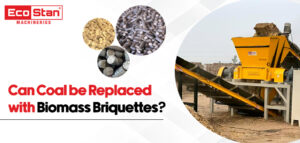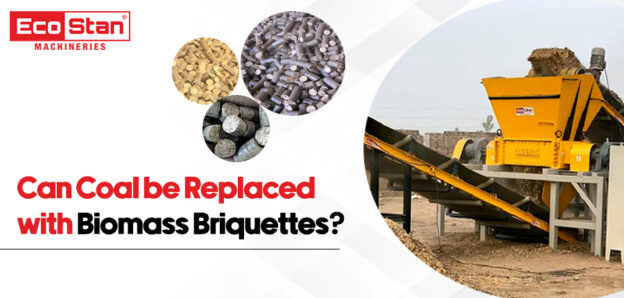ECOSTAN® Can Coal Be Replaced With Biomass Briquettes?

A biomass briquette machine produces environmentally friendly fuels with higher densities known as biomass briquettes. Because of their significant calorific value and low moisture levels, they thoroughly burn. The escalating need for renewable biomass briquettes because non-renewable fossil fuels like coal are on the verge of extinction. Nowadays, there is a growing demand for coal replacement alternatives to adopt a more eco-friendly approach to energy production.
Biomass materials are easily obtainable, and using biomass briquettes does not need special power-generation machinery. For energy production, biomass briquettes can be a more environmentally friendly alternative than fossil fuels like coal and petroleum.
Briquetting of agricultural waste is a method for producing biofuels:
You can create biomass briquettes and pellets by exerting tremendous stress on organic wastes and compacting it into blocks of different or similar shapes and dimensions. According to the type of material used to make pellets, these have low or no carbon combustion.
Briquetting is a procedure that transforms loose biomass comprising various agricultural wastes, agro-waste, and industrial raw organic wastes into energy-dense bricks of consistent size and shape. Briquettes are sometimes known as white coal or bio coal since they ignite without producing smog. Considering its environmental benefits and availability, it is not wrong to say that it can be an excellent coal replacement.
What is the calorific value of solid biomass briquettes:
According to the kind of biomass used in the production process, the calorific value of biomass briquettes varies. The following are examples of organic waste that you can use to make briquettes and pellets:
Sugarcane bagasse, groundnut seed shells, Wheat hay, wood Chips, flakes, rice straw, sawdust, and rice husk Coconut husk.
Let’s compare coal and the briquettes to know if coal replacement by biomass is ideal or not:
Availability:
Considering India is a developing nation with a large agricultural industry, there is a significant opportunity to develop a sustainable biofuel supply. Using organic wastes from industrial processes, fuels like biomass briquettes and pellets can continuously use in place of coal.
In the annual year 2021–2022, India had a record-breaking production of 780 million tonnes of domestic coal. People anticipate more outstanding fuel production in the financial year (FY) 2022–2023.
According to forecasts, the coal demand may be minimized by over 230 million tonnes if the power generation for biomass-based power generation is put to its maximum capabilities.
Emissions:
Coal and other energy sources are well-known for contributing substantially to global warming-causing greenhouse gas emissions like CO2. One economical method of reducing pollution from power sources is to use biomass briquettes and pellets.
Biomass Briquettes and pellets are a topic of discussion as an environmentally friendly substitute. However, briquettes and pellets typically produce fewer pollutants than the combustion of fossil fuels, which harms the environment.
Calorific value:
A material’s calorific value indicates heat emission when you burn a certain proportion of that substance. Coal has a calorific value of 25 to 35 MJ/kg. Among the numerous forms of coal, anthracite has the maximum calorific value. High-quality briquettes have a calorific value of around 18 and 24 MJ/kg.
The coal replacement by biomass is economical or not?
The use of coal and another power source, such as briquettes, to heat a boiler is a process known as co-firing. It can be a realistic solution that enterprises generally prefer. A benefit beyond coal burning is that this process produces fewer emissions of greenhouse gases.
For heating systems, various parameters determine when to migrate from coal to biofuels. This requires careful consideration of various factors, including:
- Accessibility and operational simplicity.
- Economic factors
- The ability of the user to adapt boilers
- Gross calorific value
- Upgrading to new boiler technology
Can briquettes take the place of coals?
It is doubtful that a complete conversion to solid biofuels will occur immediately, given our significant reliance on coal to provide energy. However, we should transition to alternative energy, as coal reserves are running out because energy requirements are expanding. In this situation, the coal replacement by biomass briquettes can be the most effective and practical energy source alternative.
Briquettes and pellets have become increasingly popular in emerging economies for lighting commercial burners. This transition will likely become even more dramatic in the following years because of increasing coal prices and depleting fossil fuel sources. Using biofuels as a coal replacement has a favorable consequences for the environment.
Biomass briquettes and pellets are an outstanding fuel source for industrial units because of their characteristics, including calorific content and power efficiency. Although various obstacles prevent them from functioning to their full potential as a coal substitute, the inclination in this path is apparent. This transition will probably occur within the next few years due to the demand for inexpensive and environmentally friendly alternative energy sources.
Conclusion: The world’s emerging fuel is the biomass briquette that you can produce by a briquetting machine. It is an incredibly effective asset for a low-cost, ecologically responsible, and forward-thinking business environmental policy. To produce power, biomass briquettes can serve as a greener substitute for fossil fuels like coal and petroleum. In light of this, the coal replacement by biomass briquettes is practical. You can get a high quality briquetting machine from Ecostan to produce briquettes as per requirement, without harming the environment.


 Click to Play Video
Click to Play Video